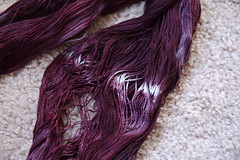

In the example above it appears the skein was tied tightly during the dye process, preventing the dye from penetrating one area. Having one or two bright white stitches every so often in an otherwise plum shawl is not to my taste. However, I certainly didn't want to overdye the whole thing and lose the lovely plum color. I figured I had two options: mix dye myself and hand-paint it onto the white, or see if I could "recycle" any excess dye already in the yarn. The latter seemed preferable given my color mixing ability, so here is what I did.
1. Soaked the skeins for 24 hours in coldish/room temperature water with just a splash of soap. I did this because silk is notoriously hard to get thoroughly wet, and any dry spots will not release or take up dye. I also pushed the skeins down carefully (don't make tangles!) several times to release trapped air bubbles.
2. Placed the skeins in my (dyeing only) crock-pot with as much water as possible.
3. Turned the heat to "high." With my crock-pot this will eventually bring the yarn to just under boiling. Crock-pots vary, so be careful.
4. This particular yarn had very little excess dye. The dye did not begin to release until the water had reached very warm temperatures.
5. I moved the yarn around to distribute the dye evenly, then added 1/4 cup of vinegar. I admit that I didn't know what type of dye had originally been used, so this was a bit of a shot in the dark. To set, acid dyes require heat and acid (vinegar), so I wanted to provide those elements to encourage the released dye to take up into the white parts of the yarn.
6. Some of the dye took up immediately. I could see the water growing clearer. Maximum uptake can be achieved by letting the yarn cool completely in the water, so I left it to cool overnight.
Not surprisingly, it was the red dye that was most prominent in the excess that was released (I don't know why, but red dye is known to be hard to fix). In my final product the white areas were turned a lighter, pinker shade of purple. Given the variation in the yarn, this should blend in fine.
A disclaimer here at the end: I'm not a dye expert, this probably won't work with anything not dyed with acid dyes, and submerging a whole skein of yarn and encouraging it to release dye could result in some DRASTIC color changes, especially if the yarn was hand-painted to start with (is this a run on yet?) However, if you've got nothing to lose, and you want to get rid of some white spots, this might work for you!


No comments:
Post a Comment